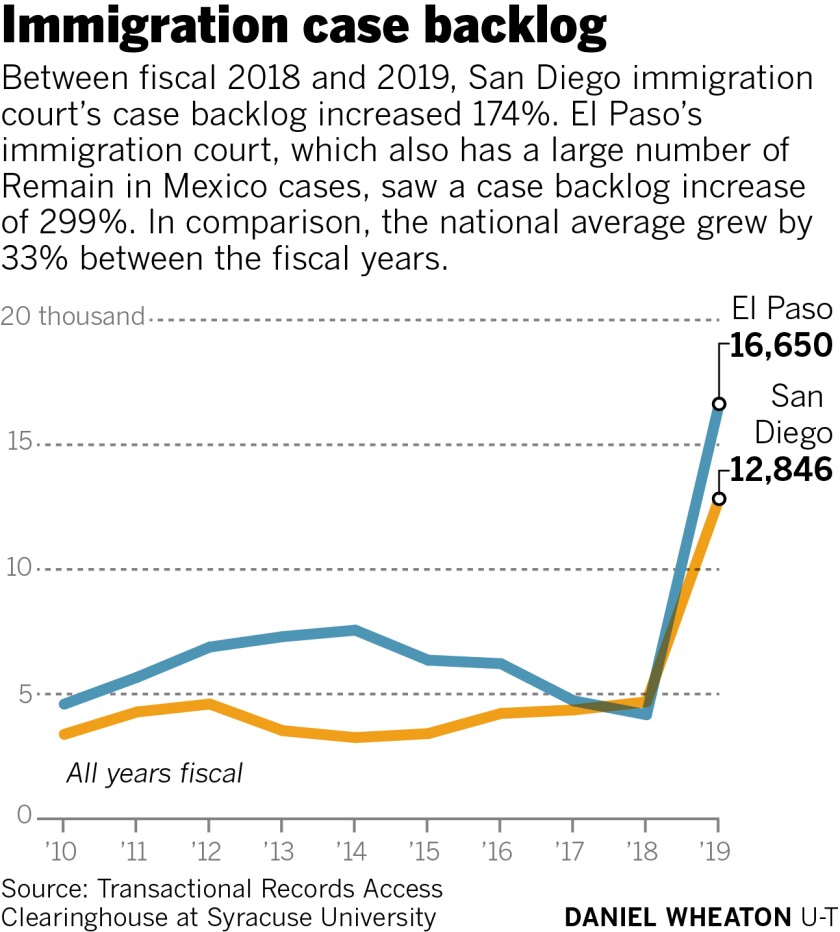The number of pending cases in San Diego’s immigration court tripled over the last year.
Between fiscal years 2018 and 2019, San Diego’s case backlog grew from 4,692 to 12,846, according to data from the Transactional Records Access Clearinghouse at Syracuse University, also known as TRAC.
Data shows that since 1998, the number of pending immigration court cases had never grown beyond 5,000 until 2019. San Diego’s backlog number far exceeded the national average, which grew by 33 percent between the 2018 and 2019 fiscal years.
Most of that growth correlates to an influx of asylum cases under the Trump administration’s controversial Remain in Mexico program.

Advertisement
The program, officially known as Migrant Protection Protocols, forces asylum seekers to live in Mexico while their court cases are adjudicated in the United States. There are more than 55,000 people in the program and nearly all of those cases are heard in immigration courts along the border.
The goal of the program is to deter migrants from filing illegitimate asylum claims as a guise to enter the United States without proper authorization. Trump administration officials have defended the program as one of the main reasons apprehensions of illegal border crossings along the southern border are down.
Previously, asylum seekers would be allowed to enter the United States and live either in detention centers or with sponsors and have their cases adjudicated in immigration courts throughout the country.
For San Diego, Remain in Mexico means that nine local immigration judges have been given more than 7,000 cases that would have previously been dispersed throughout the United States. Divided evenly, that means each judge received 788 cases since January. This is on top of all of the immigration cases they already had on their docket.
Advertisement
The drastic increase in pending cases has had a significant impact on immigration judges, lawyers and their clients.
“I think it takes a toll on morale,” said Brian Johnson, who has been an immigration attorney in San Diego for 12 years.
For lawyers, the backlog means their cases take longer to adjudicate. So instead of writing briefs, preparing for legal arguments and filing motions, they have to assume more administrative duties like organizing court calendars or explaining to clients that a case scheduled for 2019 is now postponed until 2021.
“It’s a little bit like being a therapist when we tell a client that they’re going to have to wait another year and we know that their parents are sick and you need to go back but you are going to have to put that on hold,” Johnson said.
Part of the reason morale is low, Johnson explained, is because people normally become immigration lawyers to help people. They like to practice law but because of the case backlog they are being asked to manage caseloads, be therapists and other roles they are not really trained to do.
For clients, postponed cases can be a blessing and a curse.
In some circumstances, people with pending cases in immigration court are eligible to receive legal work permits and are free to live and work in the United States without fear of deportation.
However, people with pending cases cannot travel outside the United States. That means they cannot visit sick parents or meet newborn relatives.
Advertisement
Additionally, immigration court cases take years to adjudicate. It is not uncommon for people to spend three or four years trying to adjust their immigration status through the courts. In that context, where people literally wait years for their final day in court, postponing cases for another year can seem unjust.
The influx of Remain in Mexico cases has also placed more pressure on immigration judges to adjudicate more asylum cases and to do it faster.
Between August and October, immigration courts along the border postponed already-scheduled cases so that they could focus exclusively on Remain in Mexico cases.
At the time, the president of the National Association of Immigration Judges Ashley Tabaddor said judges were hearing up to 100 per session and, “that pace is frankly not sustainable.”
Tabaddor described judges complaining about feeling burned out and stressed by the increased workload.
“I’m hearing from judges telling me they wake up tired and exhausted, that they are having dreams and nightmares about their work, that their tempers are becoming shorter, that they feel intimidated and they are afraid to speak up,” Tabaddor told The San Diego Union-Tribune in August.
Since then, several immigration judges have left work.
News reports Friday indicated that over the past year 45 immigration judges throughout the United States have left the bench — either because they moved to new roles within the Justice Department or passed away. That is nearly twice the number of judicial departures from fiscal years 2017 and 2018 which were 21 and 24 respectively, CNN reported.
Advertisement
San Diego’s immigration court isn’t the only court to experience a surge of pending cases this last year.
El Paso’s immigration court, which also has seen a large number of Remain in Mexico cases, saw a similar increase.
Data from TRAC shows that El Paso’s case backlog was 4,173 in fiscal 2018 and ballooned to 16,650 in 2019.
"last" - Google News
December 29, 2019 at 07:54PM
https://ift.tt/2u3g1ht
San Diego's immigration case backlog tripled over the last year - The San Diego Union-Tribune
"last" - Google News
https://ift.tt/2rbmsh7
Shoes Man Tutorial
Pos News Update
Meme Update
Korean Entertainment News
Japan News Update
No comments:
Post a Comment